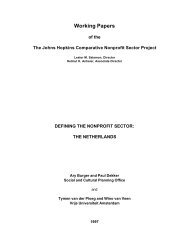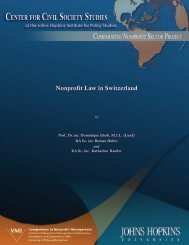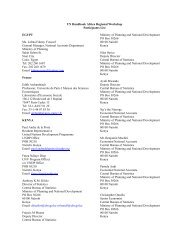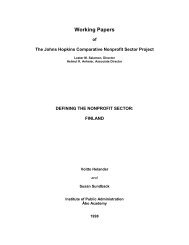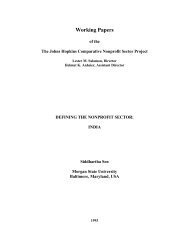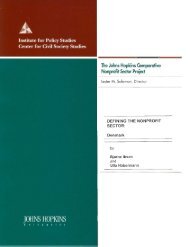Defining the Nonprofit Sector: Argentina
Defining the Nonprofit Sector: Argentina
Defining the Nonprofit Sector: Argentina
Create successful ePaper yourself
Turn your PDF publications into a flip-book with our unique Google optimized e-Paper software.
Campetella, González Bombal, and Roitter<strong>Defining</strong> <strong>the</strong> <strong>Nonprofit</strong> <strong>Sector</strong>: <strong>Argentina</strong>academic research in this area is also a new phenomenon.The second issue is related to <strong>the</strong> criteria by which to classify <strong>the</strong> different types of nonprofitorganizations. For <strong>the</strong> Argentine case, we have chosen to combine two criteria: a legal definitionemerging form <strong>the</strong> categories set by law; and a “social definition,” that is, <strong>the</strong> way in which <strong>the</strong>different organizations name <strong>the</strong>mselves and are identified in <strong>the</strong> public sphere. This decision seemsto be justified in that <strong>the</strong> law has not always accompanied <strong>the</strong> evolution and dynamics of <strong>the</strong>associative sector; and <strong>the</strong> legal definition refers to a broad, heterogeneous universe that does nothave a socially visible identity.From <strong>the</strong> legal point of view, <strong>the</strong> main terms established by <strong>the</strong> Civil Code concerning privatelaw entities without profit aims are “civil association” and “foundation.” However, as we havementioned, <strong>the</strong> provisions and definitions of <strong>the</strong> Civil Code are very general and turn out to beinadequate in <strong>the</strong> face of <strong>the</strong> complex reality and dynamics of civil society organizations. As aconsequence, <strong>the</strong>re is a wide range of rules stemming from jurisprudence, administrative or judicialsources, as well as a series of resolutions and specific regulations by public agencies. Hence, <strong>the</strong>reare nonprofit organizations that, despite being considered civil associations in <strong>the</strong> broad sense, alsoreceive special legal denominations and are subjected to <strong>the</strong>ir own regulations and regulatoryagencies. Mainly, this is <strong>the</strong> case of mutual benefit associations, cooperatives, obras sociales, andtrade unions.Besides, <strong>the</strong>re is ano<strong>the</strong>r legal term, “public good entity” which is a generic denominationgranted to all institutions registered with <strong>the</strong> National Registry of Public Good Entities. To beregistered, institutions must have already obtained legal status under any denomination eligible to beconsidered public good organizations, e.g., civil association, foundation, mutual benefit association,etc. Even though <strong>the</strong> acquisition of <strong>the</strong> status of public good entity is not compulsory, it isconvenient for nonprofit institutions as several grant-making institutions and most state agenciesdemand it when making grants or subsidies. However, as this is a second-degree qualification, weconsider it more appropriate to exclude it from our classification, as its inclusion would generatesome overlap.From <strong>the</strong> point of view of <strong>the</strong> “social definition” <strong>the</strong>re are several terms that outline differenttypes of organizations exhibiting diverse features, and most are legally constituted as civilassociations or foundations. Even though <strong>the</strong> borders among <strong>the</strong>se types of organizations are notalways clear-cut, it seems plausible to distinguish cooperators (parent-teacher associations andhospital auxiliaries); immigrant-based organizations; neighborhood associations; popular libraries;national academies and research centers; non-governmental organizations; and grassrootsorganizations.Civil AssociationsFrom a juridical perspective, Article 33 of <strong>the</strong> Argentine Civil Code 11 refers to nonprofit11Article 33 in its original version of 1869 did not distinguish, within <strong>the</strong> category “private organizations,” betweenfor-profit and nonprofit institutions. Such distinction, and <strong>the</strong>refore <strong>the</strong> definition used in this article, was made in1968 when <strong>the</strong> Civil Code was reformed.9



